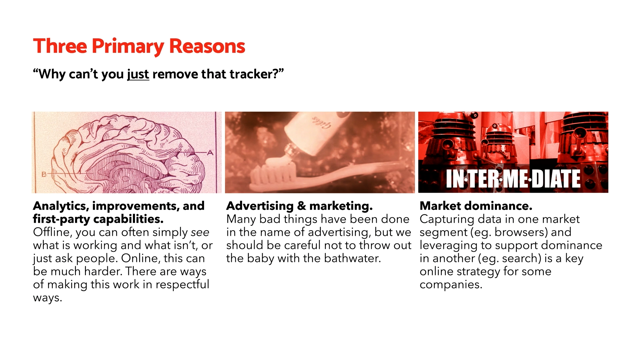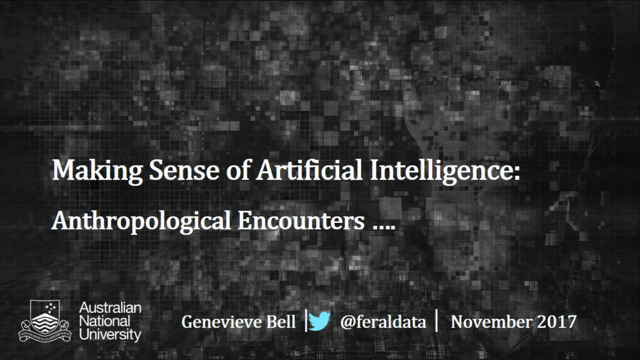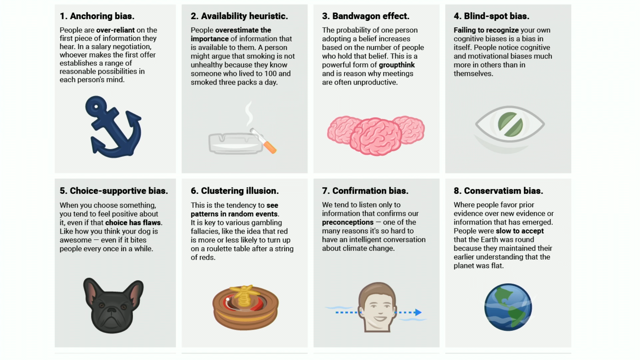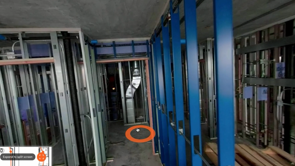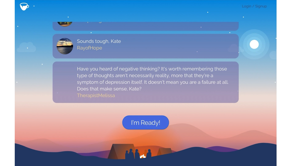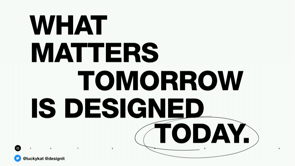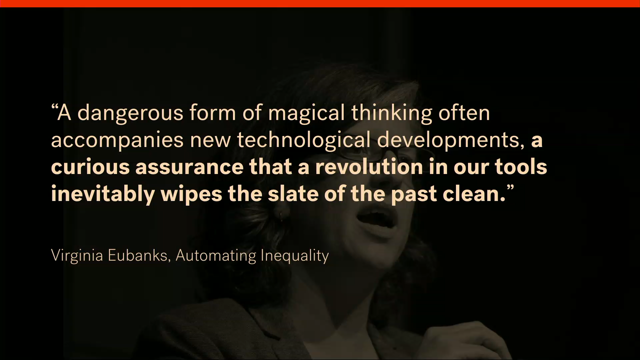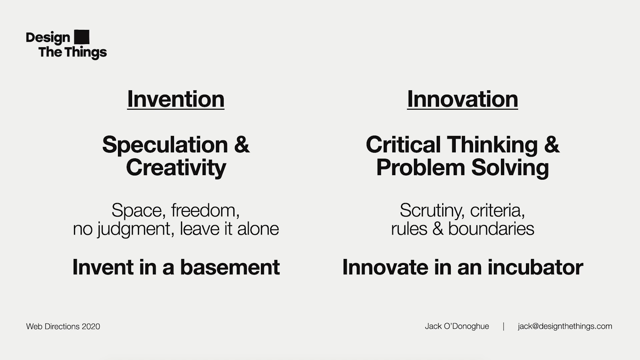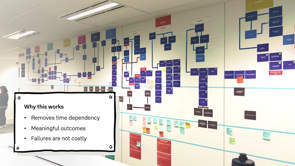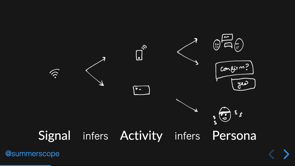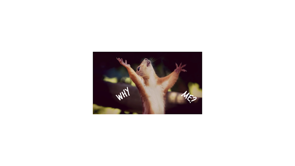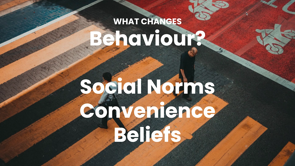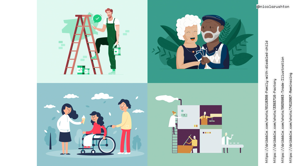
(upbeat music) - Thank you so much John, and yeah thank you so much for having me, it's really cool to be here.
I'm really happy to be here talking to today and really keen to share with you a small framework to help ask big questions about the science. So, it's been said that Walt Disney relied on three leaders to lead every project of his. The first was the idealist.
The second was the pragmatist and the third was the critic.
So the idealist was there to really dream big to have a big imagination, and to just kind of believe in that big magic, that amazing Disneyness of everything.
The pragmatist was there to look at the realities. So look at the constraints really sort of bringing back that dream a little bit closer to the real world and bring it back, to ask, how can we bring this into reality? And the third one, the critic was there to take that more sort of sceptical perspective and ask, well, firstly why should we do this at all? Should we do it? And what if this happens? What if that happens? What if the worst happens? And they were there to think about safety and to think about risk.
So I knew I as a designer can tend towards that idealistic way of thinking a little bit more. So I really love to see examples of how that's something that can be really valuable to a business.
And I think that idealism is something that's quite true for a lot of creative people.
So designers, product leaders, founders, people like us. And I think it can be natural for us creatives to really settle into that role as the idealist. But maybe this can be a reminder that it can be valuable to put on the hats of the other two sometimes when we are creating technology that goes out into the world.
So what I wanna present in the next sort of 20 minutes or so that I have of your time is one simple tool which I think we might be able to add to our toolbox as people who are building technology that comes a little bit from that critic point of view and something that I've found helpful.
So the tool.
The tool is actually a question, a question that we can ask ourselves of our product ideas, of our new features or of our designs.
And that question is, what would this look like if we scaled it up to ultra size? So what I'm not talking about is like, obviously, what does this screen look like? What would the screen look like if we scaled it up to the size of the billboard? What I am talking about is, what might this look like if we scaled the audience, the user base, the impact to ultra size.
So, let me give an example.
I worked previously for a startup that worked in property management.
So that is for anybody who's not familiar with property management, it's essentially managing rentals, so finding tenants, collecting rent, dealing with like fixing broken taps, fixing ovens, things like that.
That's property management, just for context, yeah, if it's really owning that relationship between tenants, landlords and properties.
So at the time of this project they had about 1,000 properties on the books. So they're managing about 1,000 properties. So any idea or piece of work we did at that time had an impact at that scale, so it's something like maybe two to 3,000 users like individual people because of course there are the two sides, the owners and the tenants really to teach property. So, applying this question, how would this look like if we scaled it up to ultra size. Meant saying to myself, well, okay, what if this feature that I'm designing at this time, what if instead of going out to a user base that looks like 1,000 properties, two to 3,000 people, Well, how would things look if every single rental property in Australia was managed through this startup. How would things look If the scale was more like 7 million properties.
That's around about how many rental properties there are in Australia right now.
So put aside the fact that may not actually be a goal of the company that may not be something that's within reason.
The point is really the thought experiment. So to take that perspective, what if we scaled this thing up to Uber size, to Twitter size, to Telstra size, to Facebook size and see what the impact might look like then. And taking this perspective on a new feature, a new idea that you're looking at sets make risks and abuse cases and unintended consequences really start to come into view. So let me go deeper into an example.
So let's say that we're looking at a project, looking at the way that people apply for rental properties. If you've ever applied for a rental before you know what it's like, I know I have, I've been renting for my whole adult life. I've done this process quite a number of times as a user. And I know that it can be anywhere from really really bad to just okay, maybe yeah, maybe slightly better than just okay, but probably not much far more than that, you know, it can be anything from like super awful online forms that just break and are really hard to use to even I've seen printed out paper forms that you need to take to a real estate agent, their office may not even be in the same suburb as the place that you're applying for and for such an important process, finding a home that you feel like you could love and then seeing if you can actually move in, it's a really important process and can be really, really stressful for those potential tenants.
So, okay. We're designers, we're product people we see are not so great user experience and we wanna make it better, we ask, how might we improve on that? How might we make it easier for tenants to apply for homes? So let's say we do a little brainstorming and let's say we come up with the idea, well, okay, obviously we're going to make it digital but what if we let people pre-fill the form with the social, it's gonna make it really quick for tenants to get that form done.
It's a pretty common pattern fill in a form with a social connection.
And it also, you know, if we're using something like LinkedIn it's also gonna help answer a really big question that landlords have, which is, is this person employed? Or really the real question, is this person who wants to rent my property going to be able to pay their rent regularly and reliably? So, okay. We think, okay it seems like an okay idea, it works for our key personas, let's just take a sort of normal product approach here, we might think, cool, let's market it up, we'll do a little bit of user research, maybe that user research for such a small feature it kinda just looks like one button.
Let's say we market it up, show it to a couple of users around Sydney. They're like, yeah, this seems okay, it makes sense. Some of them say, Oh yeah, I would use it, I wouldn't use it. We go, okay, yeah, cool, let's let's push it out.
It sounds like pretty normal, right? Pretty normal way to kind of approach a small tweak feature idea.
No big deal.
Or before we go too much further let's apply this question that I'm talking about. So what might this look like if we blew it up to ultra size? The audience, the impact, the user base supersize it. So instead of 1,000, now let's imagine this feature at a scale of 7 million properties, every single property in Australia imagine people are applying for their rentals through this form with this fill form with LinkedIn button. And I think when we look at it through that kind of a lens for me some of those risks and problems and issues really jump out, like, okay, firstly it's obvious one, not everyone has a LinkedIn account.
What about people who work in professions where you don't normally use LinkedIn? Tradies, retail, people in medicine and even carers, labourers, like I know tonnes of people who just don't have LinkedIn 'cause it's not really used in that field.
That means that there's a really large number of people who would be really great tenants, who don't necessarily have a LinkedIn, and so we'd be put at a small disadvantage. Let's say with this one button, we've allowed people with LinkedIn to a apply in say three minutes whereas people without LinkedIn need to spend double that amount.
At a scale of 7 million with this button did we just make it appreciably easier for people who have LinkedIn profiles? So probably you're more sort of white collar professional roles.
Did we just make it a little bit easier for them to get housing than for other people? I would suspect that it's already easier to rent a property if you have a fancy ascending job title and it's definitely easier if you've got a higher salary. Yeah. Did we just make it easier for those people, even easier? We added an extra sort of barrier for the people who are not in that group to getting a home. And if that startup scaled and grew which is of course the goal of most businesses is it possible that we could look back at some point in the future and see how our little design decisions had widened the disparity between socioeconomic groups in our country? A little scary.
Okay. Another risk.
Okay.So we filled out the application using the LinkedIn profile, you know in design what data from that LinkedIn profile was sent through to the owner, you know the landlord.
Did we send the person's picture, the potential tenants picture? Did we send their company and job title? Did we send a link to the profile? Did we say that the application was filled out using LinkedIn? And my question is what would a world look like where landlords made assessments on who their potential tenants would be in part based on a picture of their face? Like how might that go wrong? And I'm sure we can sort of imagine 7 million landlords around Australia.
Is it possible that some of them might be prejudiced against something they could see in a photo that we as tech workers in cities primarily in Australia just didn't really think of? Or could there ever be a case where a landlord choosing their tenant by picture could pose a risk for that tenant? Unfortunately we've probably all heard of at least a dodging in some way landlord.
And you know, the reality is that that person may have a key to your house, well, you can see where I'm going.
So like I think when you scale that impact right up you start to see there's potentially scary implications of these really little design choices that when we're thinking about it at a scale of, well, 1,000 landlords we know all of them, you know they're all totally fine, at that scale you don't think of it, but the point is to scale, right? And so I think if you've worked on big software products we've all seen how a seemingly little decision a long time ago or right at the start of the product when the product was really small and manageable can feel like something that's almost impossible to change down the line.
So, what do we do with this? This tool that is asking the question what would this look like if we scaled it up to ultra size? And what's the application? You know once we've asked that and we've seen these kind of potential implications and I think the answer is in the execution. So it's really about how we design and build that feature or that idea like the how, not necessarily the if.
So in this example, it doesn't necessarily mean that we don't allow that function, the apply with LinkedIn button, but it's gonna impact the execution of that feature a lot.
So we're gonna be really careful firstly that we don't let the landlord see the picture. We do not add a link to the LinkedIn profile because we don't want to make it easy for them to get to that picture or to that company address, for example.
And in fact, I think we don't even let the landlord see that the tenant did pre-fill with LinkedIn at all. We don't want the landlord to make any kind of decision based on that fact alone, just let them look at all applicants equally without us adding any additional sort of data points to to help the landlord make that distinction. 'Cause yeah, even if it's only gonna happen 1,000 times now it should be just as important at small scale that we don't build businesses that have negative impacts socially on the world around us.
And okay, so what about people who don't have LinkedIn at all? Well, we need to let them play in a way that feels just as easy and fast as the other people. So might we use Facebook? Might we use another social platform? And then when you think, okay, 7 million people, well, not everybody has either of those things. So we're gonna need to really make sure that you can apply manually.
And then you start to think about, well, what about people who don't wanna fill the format out online and so on? And I think the question here is, what do we as a business spend time on? What do we prioritise? Do we spend time making sure that the manual form is easy to fill out, simple and quick? Do we make sure that we build into our processes that every time an open home happens, the person running it should take a paper form? Even if in a year only five people take that paper form and fill out on paper, do we do we just take the time to make sure it's possible so that we're not locking some people out of getting a home? So yeah, at a 1,000 properties, I think it can easily feel less important to focus on stuff like this.
But I think if there's even one or two people who are locked out of a home because of a decision that I made as a designer, you know, I'm not really cool with that.
I think asking this question and taking this perspective also impact metrics. What are the metrics that we're gonna measure? Are we watching the differences between how long it takes somebody who filled in the form with LinkedIn versus how long it takes somebody who filled in manually? Is that a metric that we'd measure? Are we looking at the metrics of which of those two groups is successful in getting approved for the least of the most often? And do we care as a business? And what do we do with that information? Do we say to ourselves, LinkedIn users are 11% more likely to get approved for a lease than non-LinkedIn users? Cool, let's focus on those users more like we want more of those kinds of tenants, let's advertise on LinkedIn, or do we say, well, LinkedIn users are 11% more likely to be approved for at least than non-LinkedIn users? So let's take a look at our manual form, fill in and let's just check that we're not actually adding to that disadvantage throughout user interfaces and business processes. So yeah, it's not necessarily about doing this thought experiment on your feature idea, looking at those potential future examples, future implications at ultra scale and seeing potential disaster and just throwing the idea in the bin.
I think it's about seeing those implications and making the little tweaks in the execution today. How do we make things? How do we do things when it's small and when it's manageable? And then just keeping a sharp eye out for those potential consequences.
So remembering to put our critic hats on and think about it and not be sort of clouded by that idealism that helps you to not think about those potential bad things that can happen because of decisions that's what we make.
Yeah, because that's the reality for a lot of businesses is that they do aim to scale, that's kind of the goal of most businesses. And yeah, this was just really like one small example, and I just wanted to show this small example to show how it can just look like one button but then look how it scales.
Yeah. Look, I think this really comes down to our responsibilities as people working in technology. So we are seeing today some really intense and scary unintended consequences on the world that have come from tech companies.
And I mean, there's so many examples but you only need to look at like Facebook and Cambridge Analytica and the influence that may have had on global politics anti-vaccination posts on Facebook that get promoted by the algorithm because people like them and end up causing measles outbreaks.
YouTube algorithm is potentially radicalising people by recommending certain kinds of videos, the rise of the gig economy fueled by tech companies and the impact that's had on people and on society, like there's a lot, there's a lot going on and I'm sure we've all seen it.
And what's really scary to me about this is I think these impacts on the world were accidental, I think those features those products in all those companies were made by people just like you and me.
Like we know how those features get built, if we work in tech companies or in this kind of area, it's like decisions were made in meetings, just like the meetings that we sit in, those features were scoped out in JIRA or whatever programme they're using.
Maybe they did some analytics, maybe they did some user research if they're lucky, if they're actually doing user research.
And like how might this impact the world come into that process? So, yeah, I think those companies did not ask what might be the social implications on the world of these things that we're doing and not just the business implications for us and our success.
And if they did ask they asked a little too late, and they will did scale up, they all did scale up to that size and we are seeing those implications at scale. So I think that's why each of us need to look at our processes, look at the companies that we're working in and ask where does thinking about social impact and those potential impact on the world? Where does that fit in to our process? So, yeah, I don't know about you guys, but I think thinking about this stuff can feel pretty overwhelming but I feel like we have a responsibility as the creators of the tech industry, 'cause that's who we are, like, we are the tech industry.
I think we have a responsibility to do something,. to just try, to start and try to not contribute something like that to the world.
Yeah. So I honestly don't know the answer.
I don't think there is one answer.
I think it's different for every company of course but I think it's really important that we're thinking about it and that we're talking about it and that we're just asking ourselves the question, how could this go wrong? What impact could this have? And all of you have your own processes and ways of working in teams and scales that you are having impact on. And I would love to hear if you talk about this and if you do talk about it, how you talk about it.
So that's really how I'd like to end.
I would love for this to be a conversation that we'll continue into the future and I would hope that we can have a chat in the forums that the web directions teams have set up for us, really keen to check it out and also just further into our careers and into the future.
Thank you.
(upbeat music)
